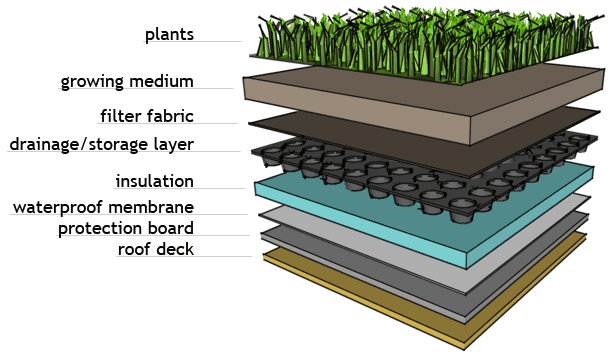Green Roof Features
A green roof is a roof of a building that is partially or completely covered with vegetation and a growing medium, planted over a waterproof membrane. Green roofs are also referred to as eco-roofs, vegetated roofs and living roofs.
There are two main categories of green roofs: “extensive” or “intensive”, depending on the depth of growing medium and amount of maintenance. For residential applications, “extensive” green roofs, with depths of 15 cm (6 inches) or less, are the most common.
How Does It Work?

A green roof starts with a waterproofing layer. For existing roofs, the existing waterproofing (asphalt shingles, tar and gravel, etc.) can be used. For new construction, a single-ply membrane such as EPDM (ethylene propylene diene monomer – a rubber typically used for pond liners) or TPO (thermoplastic polyolefin – an environmentally friendly and recyclable roofing product mostly used in large-scale commercial buildings, like the Rogers Centre) is usually used. EPDM and TPO are quick to install, and also act as a root repellent, preventing plant roots from compromising the waterproofing.
On top of the waterproofing layer are drainage, water retention and filter layers. These layers also act as root barriers. More importantly, they help manage the amount of water that is retained on the roof and ensure that the growing medium doesn’t clog the drainage layer and wash away.
Next up is the growing medium. This is usually a lightweight, custom mixture, composed mostly of expanded stone, volcanic rock, perlite, with only a 10% to 20% organic content. The goal is to find a balance between a soil that will sustain the plants, but that won’t weigh so much as to require excessive support from the building structure.
Finally, come the plants. These are chosen to match the composition and depth of the growing medium. For shallow, lightweight roofs, a mixture of sedum and delosperma varieties are typical. These shallow-rooting succulent plants do well in dry conditions (requiring less maintenance) and in “poor” soil. With deeper roofs, the plant selection can expand to include native grasses, wildflowers … even some herbs and vegetables.
Typically, a green roof also requires insulation. This can either be placed between roof rafters (as in a typical roof), or above the waterproofing layer.